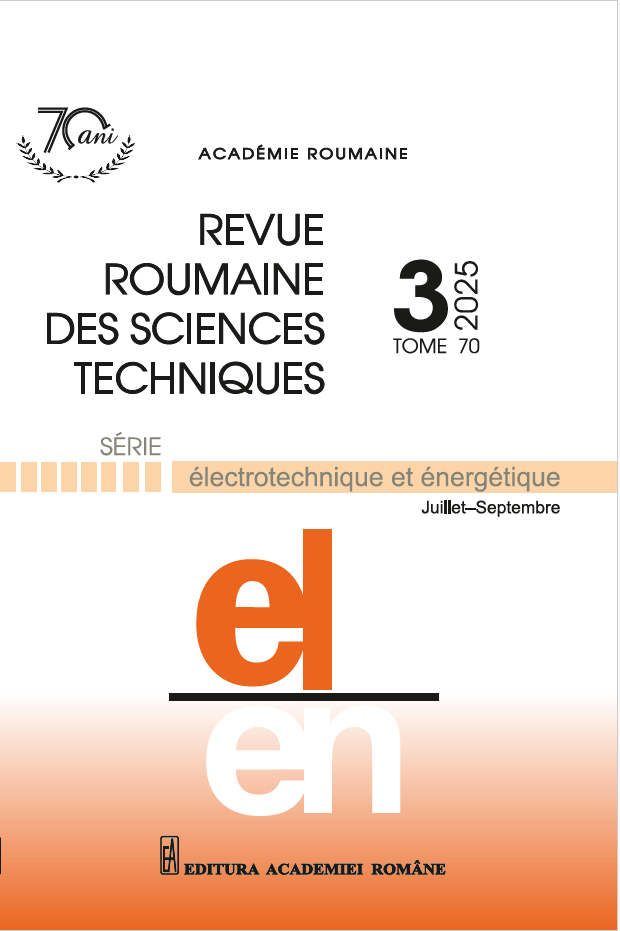HYBRID PNN-PPN 10T SRAM AND LCTS FOR LEAKAGE REDUCTION IN VLSI
DOI:
https://doi.org/10.59277/RRST-EE.2025.3.12Keywords:
Leakage current transistors, Integrated circuits, CADENCE Virtuoso, Hybrid PNN-PPN 10T SRAM, Very large-scale integration (VLSI)Abstract
scale integration (VLSI).
Leakage power, defined as the unwanted current flow when a transistor is in the OFF state, significantly impacts the power consumption and performance of VLSI designs, particularly during standby modes. Existing methods to reduce leakage power in SRAM cells often fail to strike a balance between power efficiency, stability, and performance under varying operational conditions. This study proposes a hybrid PNN-PPN 10T SRAM configuration incorporating leakage control transistors (LCTs) to mitigate leakage. The innovative design combines elements of PNN and PPN architectures, strategically integrating additional PMOS and NMOS transistors to create high-impedance paths between Vdd and ground. Using the CADENCE Virtuoso tool for circuit design and the Spectre simulator for performance evaluation, the proposed hybrid SRAM cell demonstrates significant improvements in key performance metrics. Results show a notable reduction in dynamic and leakage power consumption, enhanced speed with lower delay, and a reduced power-delay product (PDP) across varying voltage levels. Specifically, the inclusion of LCTs results in a substantial decrease in leakage power and delay, thereby contributing to overall energy efficiency and faster operation. Static noise margin (SNM) evaluation under read, write, and hold conditions further validates the robustness of the proposed design, ensuring reliable data retention and minimal leakage during standby modes. The study concludes that the proposed hybrid PNN-PPN 10T SRAM with LCTs offers a promising solution for low-power, high-performance memory applications, addressing the critical challenge of leakage power in advanced semiconductor technologies.
References
(1) C.D. Singh, H. Kaur, Factories of the Future: Technological Advancements in the Manufacturing Industry, Wiley, 1, pp. 100–125 (2023).
(2) S.M. Alarcão, V. Mendonça, C. Maruta, M.J. Fonseca, ExpertosLF: Dynamic late fusion of CBIR systems using online learning with relevance feedback, Multimedia Tools and Applications, 82, 3, pp. 11619–11661 (2023).
(3) S. Malla, P. Sahu, S. Patnaik, M. Nayak, Smart energy efficient techniques for IoT enabled wireless node, International Journal of Information Technology, 101, 2, pp. 7331–7346 (2023).
(4) R. Sathyanarayana, N.K. Ramaswamy, R.K. Ramaswamy, An efficient Low-Power reconfigurable model for CMOS-Based SRAM using FPGA, International Journal of Intelligent Systems and Applications in Engineering, 12, 4, pp. 500–515 (2023).
(5) W. Gul, M. Shams, D. Al-Khalili, FinFET 6T-SRAM All-Digital Compute-in-Memory for artificial intelligence applications: An overview and analysis, Micromachines, 14, 7, p. 1535 (2023).
(6) J. Lee, H. Bahn, Characterization of memory access in deep learning and its implications in memory management, Computers, Materials & Continua, 76, 4, pp. 607–629 (2023).
(7) M. Rastogi, L.K. Bansal, Low-Power SRAM using 7T FINFET technology, International Journal for Research in Engineering and Emerging Trends, 7, 3, pp. 570–574 (2023).
(8) T.S. Kumar, S.L. Tripathi, S.K. Sinha, Comparative analysis of leakage power in 18nm 7T and 8T SRAM cell implemented with SVL technique, International Conference on Intelligent Engineering and Management (ICIEM), 1, pp. 121–124 (2020).
(9) T.H. Kim, H. Jeong, J. Park, H. Kim, T. Song, S.O. Jung, An embedded level-shifting dual-rail SRAM for high-speed and low-power cache, IEEE Access, 8, 1, pp. 187126–187139 (2020).
(10) A. Sachdeva, V.K. Tomar, A Schmitt-Trigger based low read power 12T SRAM cell, Analog Integrated Circuits and Signal Processing, 105, 2, pp. 275–295 (2020).
(11) A. Deyasi, S. Mukhopadhyay, A. Sarkar, Novel analytical model for computing subthreshold current in heterostructure p-MOSFET incorporating Band-to-Band tunneling effect, Journal of Physics: Conference Series, 1579, 1, p. 012009 (2020).
(12) M. Moradinezhad Maryan, M. Amini-Valashani, S.J. Azhari, A new circuit-level technique for leakage and short-circuit power reduction of static logic gates in 22-nm CMOS technology, Circuits, Systems, and Signal Processing, 40, 3, pp. 3536–3560 (2021).
(13) R. Suresh Kumar, K. Ranjani, A. Rasheedha, Design of 12T SRAM cell for low power dissipation, IOP Conference Series: Materials Science and Engineering, 994, 1, p. 012045 (2020).
(14) Z. Łukasik, Z. Olczykowski, Estimating the impact of arc furnaces on the quality of power in supply systems, Energies, 13, 5, p. 1462 (2020).
(15) N. Vithyalakshmi, N. Ashok Kumar, P. Nagarajan, S. Vinoth Gopi, Low Power Design Methodology, in Very-Large-Scale Integration, Y. Kim Ho, N. Humaira (Eds.), IntechOpen, 1, Ch. 3 (2018).
(16) A.C. Ranasinghe, S.H. Gerez, Glitch-Optimized circuit blocks for low-power high-performance booth multipliers, IEEE Transactions on Very Large-Scale Integration (VLSI) Systems, 28, 2, pp. 2028–2041 (2020).
(17) P. Nagarajan, T. Kavitha, N. Ashok Kumar, A. Shirly Edward, Power energy and power area product simulation analysis of master-slave Flip-Flop, Revue Roumaine des Sciences Techniques — Série Électrotechnique et Énergétique, 68, 4, pp. 325–330 (2023).
(18) S.S. Borah, M. Gosh, A. Ranjan, Higher order multifunction filter using current differencing buffered amplifier (CDBA), Revue Roumaine des Sciences Techniques — Série Électrotechnique et Énergétique, 67, 1, pp. 59–64 (2022).
Downloads
Published
Issue
Section
License
Copyright (c) 2025 REVUE ROUMAINE DES SCIENCES TECHNIQUES — SÉRIE ÉLECTROTECHNIQUE ET ÉNERGÉTIQUE

This work is licensed under a Creative Commons Attribution-NonCommercial-NoDerivatives 4.0 International License.


